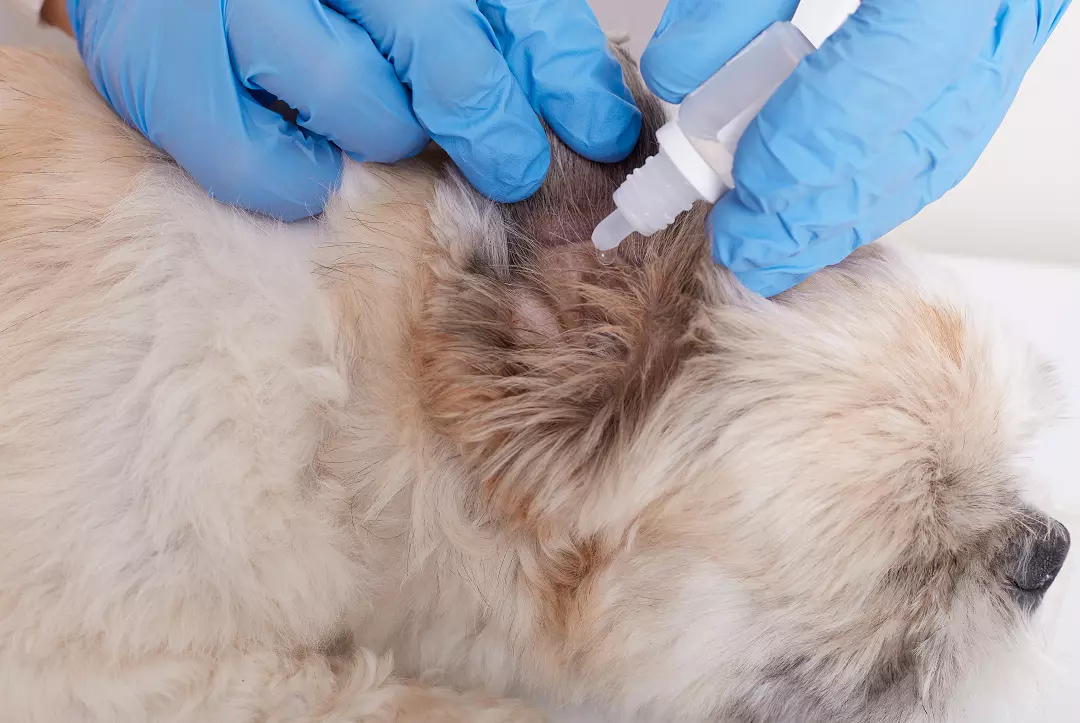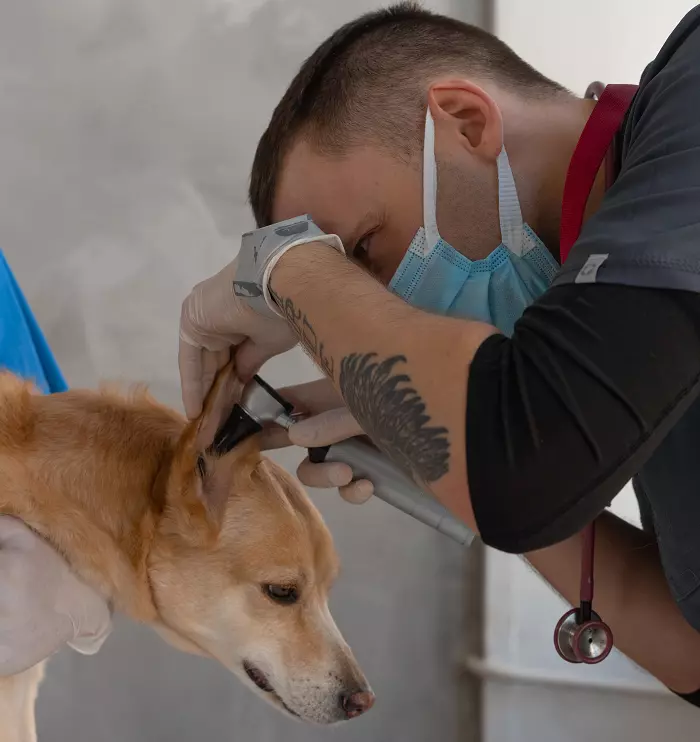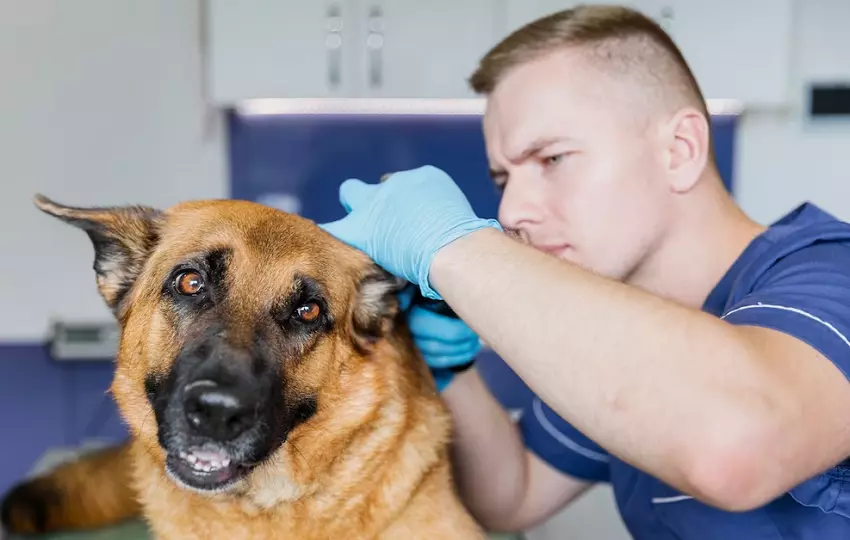How To Put Ear Drops In Uncooperative Dog: 6 Effective Tips
Cleaning your dog’s ears is an important part of grooming. It prevents infections and bad odor from forming. However, knowing how to put ear drops in uncooperative dog can be a challenge. The pooch will try to run, escape, and wiggle out of your arms. This will make the ear drop less effective, not to mention that it will splatter all over your house. The key here is proper training and utilizing positive reinforcement to encourage your dog to cooperate.
How do you put ear drops in a reluctant dog?
It’s not easy to apply an ear drop if you have an uncooperative canine. Although it’s a challenge, this treatment is very necessary to treat infections and prevent further health problems.

The following steps will help in applying ear drops on a reluctant dog:

1. Get them used to touch
You should get your dog used to touch and physical stimulation as early as possible. You should start handling their ears as soon as you bring them home.
This is what we did to our dog, Sherlock. We brought him home at 10 weeks and we start handling him regularly. Now, he doesn’t mind ear treatments anymore.
Some dogs will not be comfortable and will try to get away from your hand. You can lure the pooch back using smelly treats. Reward as soon as your dog comes back and allows you to touch its ears. Repeat this and keep giving treats as long as your dog isn’t trying to shove your hand away.
Keep these stimulation sessions short so your dog won’t be overwhelmed. Over time, you can increase the touching session by pulling the ear flap slightly and wiping the outer ear slowly.
2. Introduce the ear drop properly
Many dogs hate ear treatments because they had a traumatic or uncomfortable experience with them. I suggest letting your dog sniff the ear drop bottle first. You should also give rewards while your dog is seeing the ear drop. Just make sure that the pooch isn’t going to chew the bottle off.
Once your dog is relaxed, try putting the applicator near its ears. There’s no need to open it right away. Just see how your dog will react once you pull its ear flap upward and prop the ear drop into the ear opening. If the pooch didn’t budge, give it a treat right away.
3. Be gentle
Some pet owners are guilty of pulling their dog’s ears too tightly or forcing the pooch to sit still. Dogs don’t understand why you’re doing this. As long as they are uncomfortable, they will try to get away and escape. I suggest clipping the dog’s claws beforehand. please read here how to restrain a large dog for nail clipping

If you need to restrain your dog, it’s best to leash it so it wouldn’t run away. Also, make sure that the doggo is relaxed and not scared. You should also ask another person to hold your dog gently. Petting the dog will help it calm down. The other person can also give treats while you apply the ear drop.
4. Clean the ear
Once your dog is used to being handled and touched on the ear area, you can start cleaning its ears. This is in preparation for the application of the ear drop. Use a canine ear cleaner, some cotton balls, and paper towels. Remember that you should only use ear cleaners that are made for dogs. You should also reward with treats from time to time to distract your dog.
5. Be quick
Like kids, dogs don’t like being restrained for too long. Once your dog is in position, pull its ear flap up, squirt the ear drop, then massage it gently. You should do this in a second or two without hurting the pooch.
After administering the ear drop, give a treat so your dog will associate the experience with something positive. Repeat the same process to the other ear.
6. Let the dog shake
After applying the ear drop and massaging the dog’s ears, you should let it go. Let the dog shake its head as it likes since it helps spread the treatment. Just watch out for any splatter. It’s best to apply the ear drop in the bathroom or in a spot where you don’t mind getting streaked. please read here how to teach a dog to shake.
How often should I clean my dog’s ears?

Regular cleaning is the rule of thumb for all dogs. However, those with ear infections may need more frequent cleaning aside from ear drop application.
If your dog swims a lot or spends long periods outdoors, you may need to perform weekly cleaning. The veterinarian is the best person to ask for this so you won’t over-clean your pooch’s ears. please read here where can i take my dog to swim.
Dogs that are prone to ear infections may need frequent ear cleaning to combat the formation of dirt and bacteria. Take note that you shouldn’t wait for your dog’s ears to stink before cleaning it.
How can I treat my dog’s ear infection at home?
Ear infections should be taken seriously because it will result in a bigger health problem if not addressed. You should always consult with the vet. This way, you can perform the proper steps at home.
When Sherlock developed an ear infection, his vet recommended that we do the following. Take note that this may or may not apply to your dog. Each dog is different so you should always call your pet’s vet.
- Clean it well. Before you apply any medication, your dog’s ears must be clean. We used the same ear cleaner that we apply to Sherlock during these grooming sessions.
- Apply an ear drop. This one should be prescribed by your dog’s vet. Sure, you can find over-the-counter options but it may not be suitable for the type of infection your doggo has. Take note that dog ear infections can either be yeast, bacteria, or mites. Each one requires a specific type of treatment.
- Use a small amount of coconut oil. On days when you’re not applying ear drops, you can use a small amount of cold-pressed coconut oil. It helps soften ear wax and it will help kill remaining ear mites. But if your dog has a delicate condition, it’s best to consult the vet.
Does Benadryl help with dog ear infections?
Benadryl isn’t a cure for dog ear infections. Still, it can help to reduce itchiness in the outer portion of the ear. A small amount of Benadryl is an effective aid but I suggest calling the vet to ensure that it’s safe for your doggo.
Aside from Benadryl, it’s important to tackle the cause of ear infections. Treating only the symptoms will just prolong your dog’s suffering.
Can coconut oil help dog ear infections?
Yes, coconut oil is an excellent aid for ear infections. It kills ear mites and soothes itchiness. The bonus part is that coconut oil has a moisturizing effect that will help prevent future irritations. It will also help remove stubborn dirt and solidified earwax.
However, you should only keep it in a small amount to prevent making your dog’s ears too runny. Also, you should wipe your pet’s ear to remove the excess coconut oil.
What does a yeast infection in a dog’s ear look like?
A dog’s ear with yeast infection will lose hair around the earlobe. You will also notice bloody, yellowish, or brown discharge accompanied by a foul odor.
Aside from that, the ear flaps will have a crusty appearance aside from the swelling and redness. The dog will also shake its head incessantly in an effort to appease the itchiness and discomfort of the infection.
Advanced ear yeast infection will cause a loss of hearing and loss of balance in a dog. Your dog will also exhibit unusual eye movements as well as walking in circles. It’s important to address this infection to prevent irreversible damages to your pet’s ears.
How can I soothe my dog’s itchy ears?
My dog Sherlock often get itchy fears after a long day of running outdoors. The following are our go-to solutions to help him get rid of the irritation:
- Ear cleaner. A nice ear cleaning session will help remove the dirt causing the itchiness. However, this solution is only applicable every two weeks or once a month. If you just cleaned your dog’s ears, you should consider the other solutions here.
- Coconut oil. A drop or two of coconut oil will help neutralize the itchiness of your dog’s ears. Make sure that you will wipe the excess so it will not get into your floor and furniture.
- Benadryl. If your dog’s bet approves it, you can administer a small amount of antihistamine. We use Benadryl for Sherlock and has since yielded excellent results.
- Vet visits. If the itchiness of your dog’s ears doesn’t go away, it’s best to bring the doggo to the vet. The incessant itching may indicate a more serious condition that needs proper treatment.
Conclusion
Knowing how to put ear drops in uncooperative dog is a crucial task. It will ensure that your pooch’s irritation will be treated properly. You have to be patient and gentle to avoid scaring and hurting your pet. You can also consult the vet if you’re having a hard time dealing with your reluctant canine.
